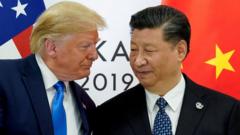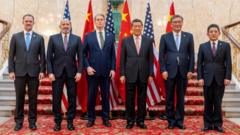As President Trump's tariffs on steel and aluminum took effect, the E.U. and Canada swiftly announced billions in retaliatory tariffs aimed at U.S. exports, raising concerns about escalating trade tensions and economic impacts.
Europe and Canada Strike Back: New Tariffs in Response to U.S. Trade Policies

Europe and Canada Strike Back: New Tariffs in Response to U.S. Trade Policies
The trade landscape has shifted as the E.U. and Canada impose retaliatory tariffs against the U.S., igniting a broader economic confrontation.
The trade war escalated on March 12, 2025, as the European Union (E.U.) and Canada declared new tariffs intended to counter recent U.S. levies on steel and aluminum. President Trump's imposition of approximately $26 billion in tariffs prompted the E.U. to set retaliatory tariffs that will launch on April 1. Officials from the bloc have indicated that they remain optimistic about reaching an agreement, despite the ongoing tensions.
The E.U.’s strategy will unfold in two phases. The first phase involves the expiration of tariff suspensions that were enacted under President Biden, which will result in the reintroduction of duties on numerous products, including motorcycles, bourbon, and boats. The second phase will see an additional $18 billion worth of tariffs applied, although specific products have yet to be listed.
On the Canadian front, the government responded by imposing new tariffs on $20 billion in U.S. goods, with a focus on steel, aluminum, tools, computers, and sporting goods. This collective action from both allies signifies a notable shift in North America’s trade relations and raises questions about the future of U.S. economic policies.
Interestingly, some allies like Britain and Australia have opted for restraint. The U.K.'s Prime Minister Keir Starmer has chosen not to retaliate, with an eye toward negotiating a long-term trade agreement with the United States. Similarly, Australia’s Prime Minister Anthony Albanese expressed concerns that reciprocal tariffs would detrimentally impact local consumers.
As the situation develops, it underscores the complexities of international trade relations and the potential ripple effects of protectionist policies on a global scale.























